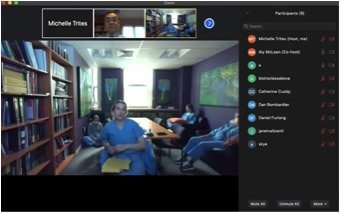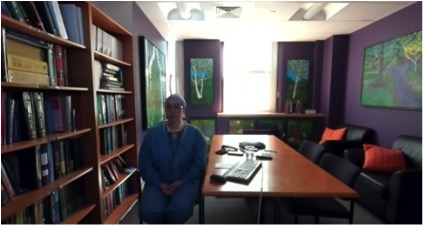COVID-19
Mindfulness Meditation to Promote Staff Wellness During COVID-19
By Yuan-Chi Lin, MD, MPH; Alyson F. McLean, CRNA; Jue T. Wang, MD
Department of Anesthesiology, Critical Care and Pain Medicine
Boston Children’s Hospital
Department of Anaesthesia
Numerous Childrens’ Hospital staff face extraordinary stressors in their daily working environment. Many of these have always been associated with our profession; such as working extended hours, caring for pediatric patients with serious illnesses, dealing with pain and emotional suffering, helping patients and their family to make the best decisions for their care, and providing support for colleagues. We go along for years, moving through our days propelled by daily routine. The unfolding coronavirus disease 2019 (COVID-19) pandemic is transforming our stressful lives and complicated patient care system more than any other crisis in modern history. We feel a sense of groundlessness and an element of fear because we have been stripped of our usual normal routine.
Meditation techniques are components of mind–body medicine that have gained wide acceptance within conventional medicine.1 The physiology of meditation relaxation response include reduced metabolism, blood pressure, heart rate and respiration rate.2 Mindfulness is a technique which promotes awareness; cultivated by paying attention in the present moment, and non-judgmentally. It is an essential component of one of the many forms of meditation. Well-being is not just the absence of diseases. This once-a-week guided mindfulness meditation program aims to reduce stress and promote well-being for the pain and perioperative medical staff during COVID-19. Mindfulness is reconnection with life, with reality and imagination, with the beauty of your own being, with your heart and body and mind.3
Mindfulness Meditation Program
This mindfulness meditation program is offered for our perioperative care and pain medicine staff working at Boston Children’s Hospital. The instructors are experienced and trained in meditation. The intervention consists of a mindfulness meditation group lasting one hour each week on Zoom. Participants are also asked to practice meditation once a day for twenty minutes or ten minutes twice a day, every day. Participants then complete the Profile of Mood States scale and the Perceived Stress Scale, weekly.

Figure 1. Alyson F. McLean, CRNA, provided mindfulness meditation for stress reduction via Zoom.

Figure 2. Jue T. Wang, MD, led the mindfulness meditation session in the Anesthesia Library.
The Practice
You sit in a quiet location. You do not require a perfectly silent or beautiful place for meditation. All you want is a spot without too many distractions, background noise or proximity to other people who may disturb you.
You can be aware with your eyes closed, and you can be aware with your eyes open. Both have unique advantages so you might want to experiment with both. Starting with your eyes closed would probably cause less distraction.
The gesture of your body during the meditation practice is important. You should sit comfortably. You may be standing still or walking. If you choose a chair, try to sit down with your feet uncrossed and flat on the floor. If possible, sit with your back away from the back of the chair so your back is self-supporting. Ultimately choose whatever posture is least likely to cause increasing unpleasant sensation with a longer period of time. Your hands should rest comfortably. You may keep them folded in your lap, with the fingers of the left hand lying on the top of the right fingers and the thumb tips touching.4
Loosen your muscles with a head to toes body scan. You may silently replicate a mantra, prayer, phrase, or sound.
When wandering thoughts interfere, as they will, let them come and go and return to your sacred words, kindness phrases, or chummy sound. Continue to practice awareness of your breathing in a comfortable sitting or lying posture.
Give yourself six months to practice it whether you like it or not. Do it for yourself and for your love of life rather than with a goal to improve yourself or be a better person.
It is best to make a time and a place in your home to practice each day; a time just for you. The guided meditations are not that long by the clock, so it is helpful to give yourself over to the enduring quality of the present moment every time you practice. It is the quality of your motivation that sets the tone for your openness to experiencing whatever it is that arises.
Results
The feedback was overwhelmingly positive. The followings are some of responses:
The meditation sessions are so important especially during the COVID-19. It gives me a peace of mind.
Great very helpful.Case in my room was behind. The next case’s surgical staff was pushing us to get the case done. Meditation training helped stay focus and to avoid making mistake.
Love meditation Thursday session.
I enjoy so much and have made it part of my daily routine.
Instructions are very helpful. Looking forward the daily meditation practice.
The teaching methods and awareness are so helpful.
So thankful that you are providing the class. I am trying to incorporate the mindfulness teaching into my everyday living.
Discussion
Research has been done to establish the foundation of mindfulness meditation. In one study, ninety patients with chronic pain were trained in a ten-week stress reduction and relaxation program consisting of mindfulness meditation. By the end of the program, ratings of pain intensity, activity interference, physical symptoms, and anxiety and depression were significantly reduced. Pain-related medication utilization was also decreased.5 Another study randomly assigned forty subjects to either brief mindfulness meditation training or a control group without mindfulness meditation. The meditation group demonstrated an increased heat pain threshold and more tolerance to tonic pain stimuli compared to the control group.6
An RCT evaluated the effectiveness of mindfulness-based stress reduction in 342 patients with chronic low back pain compared with a control group. At 26 weeks, the percentage of participants with clinically meaningful improvement on the Roland Disability Questionnaire was higher among those who received mindfulness-based stress reduction and cognitive behavioral therapy than for usual care.
Mindfulness-based stress reduction may also be an effective treatment option for patients with chronic low back pain.7 A 26-week RCT of 35 patients with opioid treated chronic low back pain showed positive benefit from mindfulness meditation with increased acceptability and feasibility compared with cognitive behavioral therapy (CBT).8 Functional magnetic resonance imaging (fMRI) has been used to assess the impact of mindfulness meditation neural mechanisms in healthy human subjects. Four days of mindfulness meditation training significantly reduced pain intensity ratings and decreased activity of the primary somatosensory cortex when healthy subjects were presented with a noxious stimulus.9 Overall mindfulness meditation is categorized as having positive scientific evidence.
There has been a surfeit of available data about burnout among anesthesia providers.10 The challenges associated with extremely limited resources and devastating burnout continue globally.11 We frequently engage in our daily schedule as if it is a mechanical routine. We tend to get a little bit programmed. We do not question our minds or do too much reflection.
COVID-19 gives us the courage to break the old habits and bring us all together. Together we all tried to prevent the disease spread, discover the proper treatment and develop the new vaccine. This is a great opportunity for us to check our habits, examine our biases, and replenish our spiritual, emotional, and psychological coffers. Mindfulness meditation can support healthcare professionals during this COVID-19 global pandemic.12 Mindfulness meditation helps us acknowledge the fear, realize the interdependence, and cultivate compassion as well as kindness in action.
References
- Dossett ML, Fricchione GL, Benson H. A New Era for Mind-Body Medicine. N Engl J Med 2020;382:1390-1.
- Benson HP, William. Relaxation Revolution: The Science and Genetics of Mind Body Healing. New York: Scribner; 2011.
- Kabat-Zinn J. Meditation is not what you think. New York, Boston: Hachette Books; 2018.
- Kabat-Zinn J. Full Catastrophe Living. New York: Bantam Books; 2013.
- Kabat-Zinn J, Lipworth L, Burney R. The clinical use of mindfulness meditation for the self-regulation of chronic pain. J Behav Med 1985;8:163-90.
- Reiner K, Granot M, Soffer E, Lipsitz JD. A Brief Mindfulness Meditation Training Increases Pain Threshold and Accelerates Modulation of Response to Tonic Pain in an Experimental Study. Pain Med 2016;17:628-35.
- Cherkin DC, Sherman KJ, Balderson BH, et al. Effect of Mindfulness-Based Stress Reduction vs Cognitive Behavioral Therapy or Usual Care on Back Pain and Functional Limitations in Adults With Chronic Low Back Pain: A Randomized Clinical Trial. JAMA 2016;315:1240-9.
- Zgierska AE, Burzinski CA, Cox J, et al. Mindfulness Meditation-Based Intervention Is Feasible, Acceptable, and Safe for Chronic Low Back Pain Requiring Long-Term Daily Opioid Therapy. J Altern Complement Med 2016;22:610-20.
- Zeidan F, Martucci KT, Kraft RA, Gordon NS, McHaffie JG, Coghill RC. Brain mechanisms supporting the modulation of pain by mindfulness meditation. J Neurosci 2011;31:5540-8.
- Milenovic MS, Matejic BR, Simic DM, Luedi MM. Burnout in Anesthesiology Providers: Shedding Light on a Global Problem. Anesth Analg 2020;130:307-9.
- Kudsk-Iversen S, Shamambo N, Bould MD. Strengthening the Anesthesia Workforce in Low- and Middle-Income Countries. Anesth Analg 2018;126:1291-7.
- Behan C. The benefits of meditation and mindfulness practices during times of crisis such as COVID-19. Ir J Psychol Med 2020:1-3.




